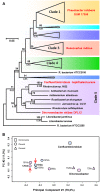Plasmid Transfer in the Ocean - A Case Study from the Roseobacter Group
- PMID: 28769910
- PMCID: PMC5513947
- DOI: 10.3389/fmicb.2017.01350
Plasmid Transfer in the Ocean - A Case Study from the Roseobacter Group
Abstract
Plasmid mediated horizontal gene transfer (HGT) has been speculated to be one of the prime mechanisms for the adaptation of roseobacters (Rhodobacteraceae) to their ecological niches in the marine habitat. Their plasmids contain ecologically crucial functional modules of up to ∼40-kb in size, e.g., for aerobic anoxygenic photosynthesis, flagellar formation and the biosynthesis of the antibiotic tropodithietic acid. Furthermore, the widely present type four secretion system (T4SS) of roseobacters has been shown to mediate conjugation across genus barriers, albeit in the laboratory. Here we discovered that Confluentimicrobium naphthalenivorans NS6T, a tidal flat bacterium isolated in Korea, carries a 185-kb plasmid, which exhibits a long-range synteny with the conjugative 126-kb plasmid of Dinoroseobacter shibae DFL12T. Both replicons are stably maintained by RepABC operons of the same compatibility group (-2) and they harbor a homologous T4SS. Principal component analysis of the codon usage shows a large similarity between the two plasmids, while the chromosomes are very distinct, showing that neither of the two bacterial species represents the original host of those RepABC-2 type plasmids. The two species do not share a common habitat today and they are phylogenetically only distantly related. Our finding demonstrates the first clear-cut evidence for conjugational plasmid transfer across biogeographical and phylogenetic barriers in Rhodobacteraceae and documents the importance of conjugative HGT in the ocean.
Keywords: conjugation; evolution; horizontal gene transfer; plasmid synteny; type IV secretion systems.
Figures


Similar articles
-
Fatal affairs - conjugational transfer of a dinoflagellate-killing plasmid between marine Rhodobacterales.Microb Genom. 2022 Mar;8(3):000787. doi: 10.1099/mgen.0.000787. Microb Genom. 2022. PMID: 35254236 Free PMC article.
-
Gene Flow Across Genus Barriers - Conjugation of Dinoroseobacter shibae's 191-kb Killer Plasmid into Phaeobacter inhibens and AHL-mediated Expression of Type IV Secretion Systems.Front Microbiol. 2016 May 31;7:742. doi: 10.3389/fmicb.2016.00742. eCollection 2016. Front Microbiol. 2016. PMID: 27303368 Free PMC article.
-
The Composite 259-kb Plasmid of Martelella mediterranea DSM 17316T-A Natural Replicon with Functional RepABC Modules from Rhodobacteraceae and Rhizobiaceae.Front Microbiol. 2017 Sep 21;8:1787. doi: 10.3389/fmicb.2017.01787. eCollection 2017. Front Microbiol. 2017. PMID: 28983283 Free PMC article.
-
Extrachromosomal, extraordinary and essential--the plasmids of the Roseobacter clade.Appl Microbiol Biotechnol. 2013 Apr;97(7):2805-15. doi: 10.1007/s00253-013-4746-8. Epub 2013 Feb 24. Appl Microbiol Biotechnol. 2013. PMID: 23435940 Review.
-
Conjugative DNA-transfer in Streptomyces, a mycelial organism.Plasmid. 2016 Sep-Nov;87-88:1-9. doi: 10.1016/j.plasmid.2016.09.004. Epub 2016 Sep 28. Plasmid. 2016. PMID: 27687731 Review.
Cited by
-
Characteristics and Evolutionary Analysis of Photosynthetic Gene Clusters on Extrachromosomal Replicons: from Streamlined Plasmids to Chromids.mSystems. 2019 Sep 10;4(5):e00358-19. doi: 10.1128/mSystems.00358-19. mSystems. 2019. PMID: 31506262 Free PMC article.
-
A marine plasmid hitchhiking vast phylogenetic and geographic distances.Proc Natl Acad Sci U S A. 2019 Oct 8;116(41):20568-20573. doi: 10.1073/pnas.1905878116. Epub 2019 Sep 23. Proc Natl Acad Sci U S A. 2019. PMID: 31548387 Free PMC article.
-
Where the plasmids roam: large-scale sequence analysis reveals plasmids with large host ranges.Microb Genom. 2019 Jan;5(1):e000244. doi: 10.1099/mgen.0.000244. Microb Genom. 2019. PMID: 30625112 Free PMC article.
-
Fatal affairs - conjugational transfer of a dinoflagellate-killing plasmid between marine Rhodobacterales.Microb Genom. 2022 Mar;8(3):000787. doi: 10.1099/mgen.0.000787. Microb Genom. 2022. PMID: 35254236 Free PMC article.
-
Longitudinal Microbiome Investigations Reveal Core and Growth-Associated Bacteria During Early Life Stages of Scylla paramamosain.Microorganisms. 2024 Nov 29;12(12):2457. doi: 10.3390/microorganisms12122457. Microorganisms. 2024. PMID: 39770661 Free PMC article.
References
-
- Biebl H., Allgaier M., Tindall B. J., Koblizek M., Lünsdorf H., Pukall R., et al. (2005). Dinoroseobacter shibae gen. nov., sp. nov., a new aerobic phototrophic bacterium isolated from dinoflagellates. Int. J. Syst. Evol. Microbiol. 55 1089–1096. - PubMed
LinkOut - more resources
Full Text Sources
Other Literature Sources
Molecular Biology Databases

